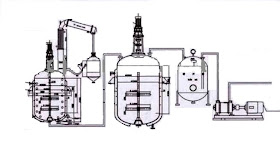Process description
Alkyd resin can be manufactured by four different processes, solvent process being the main commercial process which starts by adding all the raw materials in reaction kettle and the agitation of the same is continued then, inert gas is sparged through the spare line.
The vapour are condensed and recycled back to the kettle.

The vapour are condensed and recycled back to the kettle.
The reacted mass is dropped into a jacketed tank, containing the desired solvent. The cooled resin solution after thinning is filtered in filter press and sludge is removed. It is lastly tested, packed and stored.
The solvent process uses a small amount of solvent, 5-10%, in the esterfication reaction to act as a reflux medium.
The advantages of this process are:
a) Uniformity of product,
b) Increased speed of reaction and
c) Lower material losses.
In the solvent process, the production of alkyds can be carried out either in a single stage or a two stage process. Under the single stage process, the drying oil (linseed oil), polyalcohol and phthalic anhydride are converted simultaneously. This method of alkyd preparation is not satisfactory because of the incompatibility of the phthalic anhydride with drying oil (linseed oil) and the difficulty of controlling the reaction to produce the desired end-products.
In the first sage of the two stage solvent process, monoglyceride is produced from drying oil and polyalcohol and in the second stage the monoglyceride is converted with phthalic anhydride. This process is more satisfactory and is the one recommended for the envisaged plant because it eliminates the problems of the first option.
In the two- stage solvent process, the first operation is the alcholoysis reaction which takes place under different duration of time (varying form 40 minutes to 4 hours) and temperature (from about 240 to 260oC). The completion of this stage is shown by the solubility of the product in about twice its weight of methanol.
The second stage which takes place in the same reactor is the actual formation of the alkyd proper. The monoester formed in the first stage is cooled slightly to about 210oC and the requisite quantity of phthalic anhydride is added. The resin is then partially cooled with water coils, and at the same time a thinning solvent is added. The partially diluted alkyd solution is run into a blender, passing through a filter press to remove any gel particles that are formed. The completed alkyd solution is then pumped to a second filter press for clarification and then to storage tanks or immediate use
The solvent process uses a small amount of solvent, 5-10%, in the esterfication reaction to act as a reflux medium.
The advantages of this process are:
a) Uniformity of product,
b) Increased speed of reaction and
c) Lower material losses.
In the solvent process, the production of alkyds can be carried out either in a single stage or a two stage process. Under the single stage process, the drying oil (linseed oil), polyalcohol and phthalic anhydride are converted simultaneously. This method of alkyd preparation is not satisfactory because of the incompatibility of the phthalic anhydride with drying oil (linseed oil) and the difficulty of controlling the reaction to produce the desired end-products.
In the first sage of the two stage solvent process, monoglyceride is produced from drying oil and polyalcohol and in the second stage the monoglyceride is converted with phthalic anhydride. This process is more satisfactory and is the one recommended for the envisaged plant because it eliminates the problems of the first option.
In the two- stage solvent process, the first operation is the alcholoysis reaction which takes place under different duration of time (varying form 40 minutes to 4 hours) and temperature (from about 240 to 260oC). The completion of this stage is shown by the solubility of the product in about twice its weight of methanol.
The second stage which takes place in the same reactor is the actual formation of the alkyd proper. The monoester formed in the first stage is cooled slightly to about 210oC and the requisite quantity of phthalic anhydride is added. The resin is then partially cooled with water coils, and at the same time a thinning solvent is added. The partially diluted alkyd solution is run into a blender, passing through a filter press to remove any gel particles that are formed. The completed alkyd solution is then pumped to a second filter press for clarification and then to storage tanks or immediate use
